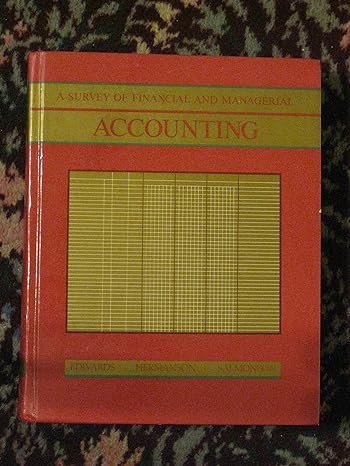Question
CASE STUDY: In-Class Group Activity The president of BYC, an Indian commercial bank, received an anonymous note in his mail stating that three bank employees
CASE STUDY: In-Class Group Activity The president of BYC, an Indian commercial bank, received an anonymous note in his mail stating that three bank employees were making fraudulent loans. The banks internal auditor teams investigations showed that three trusted employees who worked for more than 10 years in the bank, and amongst them a branch manager, were able to obtain over $1.2 million in fraudulent loans taken out over a three-year period and have used the embezzled money for their own personal expenses. Court documents revealed that 53 fake loans were originated and ranged in amount from $10,000 to $50,000. The bank employees created fake loan applications, which were taken out by the employees in different names, including their wifes maiden name, their mothers name, and the names of their friends. These people denied receiving stolen funds or knowing anything about the bank fraud and embezzlement. According to court documents, Robb Narayini, used his position as a loan officer at the bank to cosign the checks and approve the fraudulent loans. In addition, Nira Radia, head teller, cashed checks for different persons, whom she didnt know, and whose names were on the loans. While other times, the money was given directly to the employees. The three bank employees who engaged in the fraud, were initially authorized to make consumer loans up to a certain dollar limit without loan committee approvals. The original lending limit was $10,000, the amount of the first fraudulent loan. The dollar limit was later increased to $15,000 and then increased again to $25,000. Some of the loans, including the one for $50,000, far exceeded their lending limit. In addition, all loan applications should have been accompanied by the applicants credit history report. The loan taken out in the fictitious name would not have had a credit report and should have been flagged by a loan review clerk at the banks headquarters. News reports raised questions about why the fraud was not detected earlier. State regulators and the banks internal auditors failed to detect the fraud. Several reasons were given for the failure to find the fraud earlier. First, in checking for bad loans, bank auditors do not examine all loans and generally focus on loans much larger than the ones in question. Second, the banks loan review clerks were rotated frequently, making follow-up on questionable loans more difficult. The banks losses totaled $452,000, which was less than the $1.2 million in bogus loans, because the employees used a portion of the borrowed money to repay loans as they came due. The banks bonding company covered the loss. The bank experienced other adverse publicity prior to the frauds discovery. First, the bank was fined $50,000 after pleading guilty to failure to report cash transactions exceeding $10,000, which is a felony. Second, bank owners took the bank private after a lengthy public battle with the State Attorney General, who alleged that the bank inflated its assets and overestimated its capital surplus to make its balance sheet look stronger. The bank denied this charge. 1. What strategies did the employees follow to commit the fraud and conceal it? 2. Good internal controls require that the custody, recording, and authorization functions be separated. Explain which of those functions the employees had and how the failure to segregate them facilitated the fraud. 3. Recommend actions and/or preventive, detective, and corrective controls to be implemented at BYC, that would correct the problems and minimize the risk of future frauds. 4. Explain how the principle of segregation of duties is violated in this case.
1. What strategies did the employees follow to commit the fraud and conceal it?
2. Good internal controls require that the custody, recording, and authorization functions be separated.
3. Explain which of those functions the employees had and how the failure to segregate them facilitated the fraud.
4. Recommend actions and/or preventive, detective, and corrective controls to be implemented at BYC, that would correct the problems and minimize the risk of future frauds.
5. Explain how the principle of segregation of duties is violated in this case.
Step by Step Solution
There are 3 Steps involved in it
Step: 1

Get Instant Access to Expert-Tailored Solutions
See step-by-step solutions with expert insights and AI powered tools for academic success
Step: 2

Step: 3

Ace Your Homework with AI
Get the answers you need in no time with our AI-driven, step-by-step assistance
Get Started


